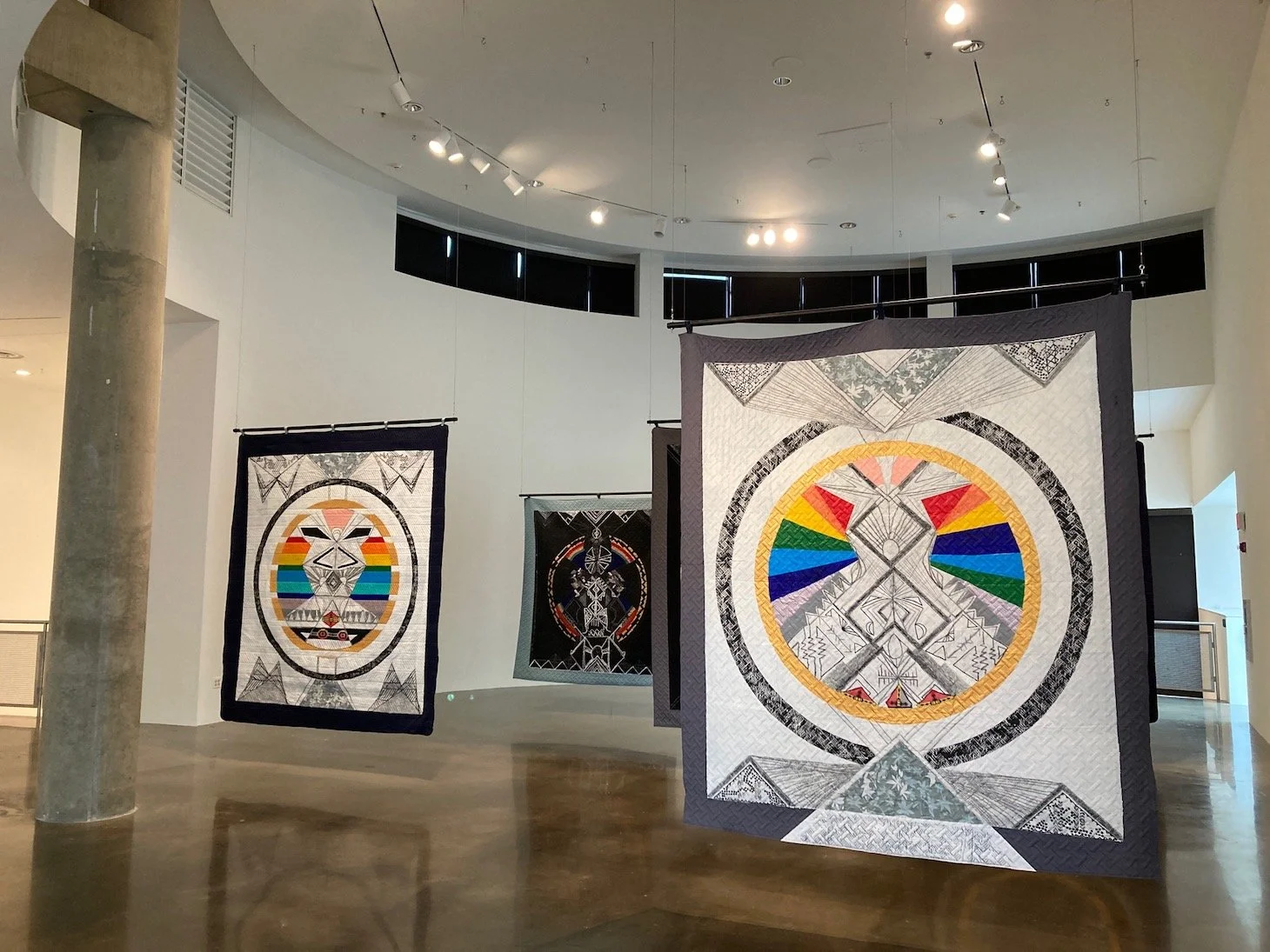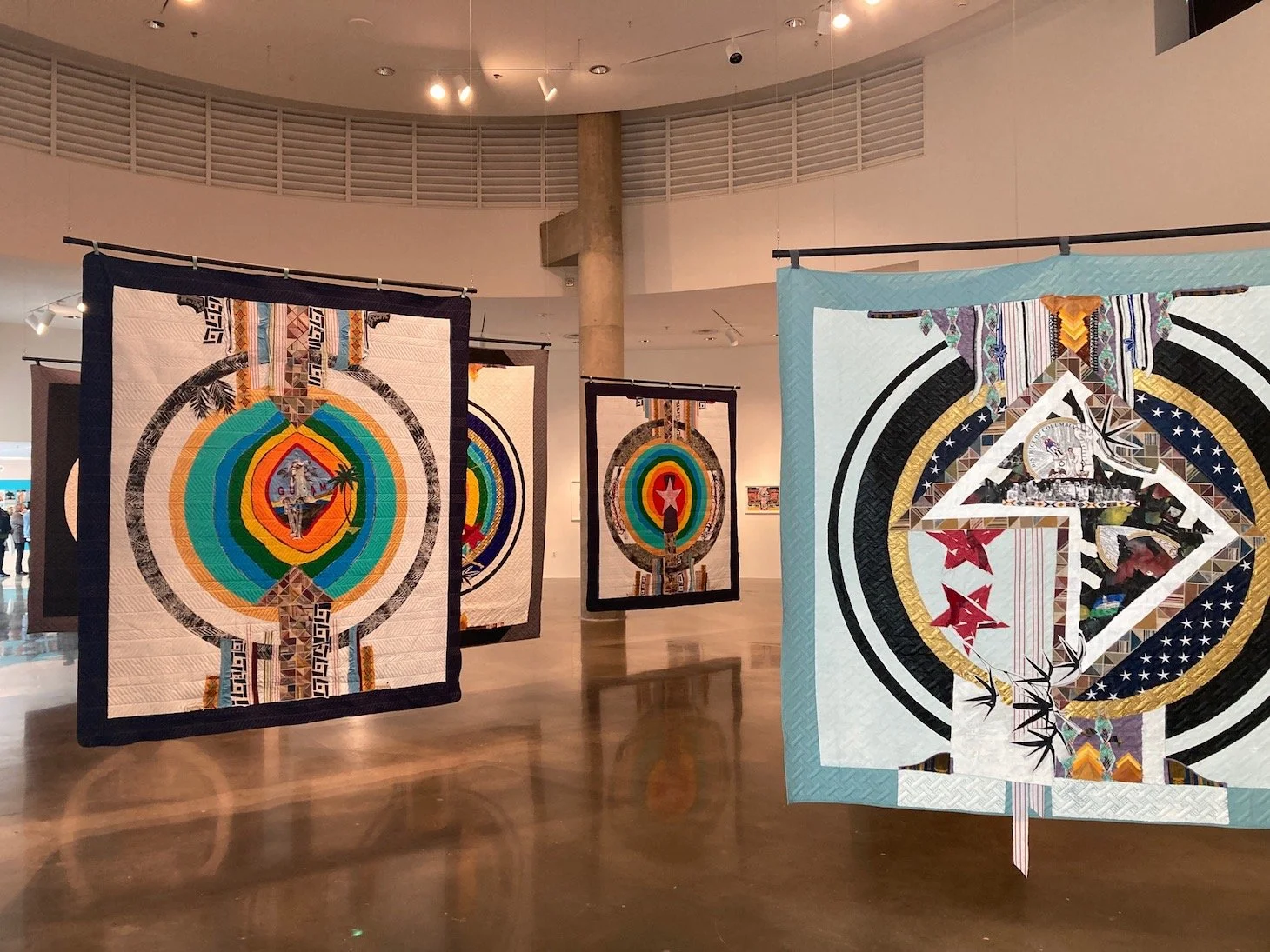The Liminal Space of Identity for Residents of US Territories
In Amber Robles-Gordon’s artwork, the borders between states matter less than the overlapping territories of self, the never-ending negotiation of identity.
by Kriston Capps
Washington, DC — Seven “flags” hang in Amber Robles-Gordon’s show at the American University Museum: one for each of the five unincorporated United States territories in the Caribbean, one for the District of Columbia, and one to signify the artist’s place in between those locales.
Each of these quilted, banner-like pieces has two sides: one personal, one political. This makes 14 flags — and countless subdivisions, really, considering all the fault lines and fractures that compose the quilted surfaces. They aren’t literal territorial emblems, but like the actual flags they resemble, these banners make a constitutional statement, about one person, divisible, beautifully so.
Suspended from the third-floor atrium, the seven flags are a showstopper in Successions: Traversing US Colonialism. For this show, which was curated by Larry Ossei-Mensah and also includes mixed-media collages on canvas, Robles-Gordon set out to explore her own Caribbean roots. The artist couples traditional textiles with an approach to abstraction that draws on Washington’s rich painting legacy to reflect the dynamism of the African diaspora, and where she dwells within it.
Amber Robles-Gordon, “Observación de influyentes: culturra y herencia Taina, el clima y el machismo” (“Observation of Influencers: Taino Culture and Heritage, the Climate and Machismo”) (2020), mixed-media collage on canvas, 18 x 24 inches
Robles-Gordon, who is Afro-Latina, spent much of the pandemic between San Juan, Puerto Rico, where she was born, and the District of Columbia, where she lives and works. The ideas that culminated with this body of work are informed by research into state borders, social systems, and political hierarchies. Yet the show brims with improvisation, color, and self-discovery.
Robles-Gordon borrows from insignia of the US territories while building her own personal cosmology of symbols to assert her supra-national identity. For the front side of her Virgin Islands quilt, titled “USVI Political” (2021), she deploys the shield banner and eagle emblem of the territory’s flag. The artist juxtaposes arrows, laurels, and other figurative elements with abstract bands of color alongside collaged images of Virgin Islands license plates. A gold chain hangs over the whole thing — just a dash of Robert Rauschenberg. “USVI Spiritual, Moko Jumbie: Walk Tall and Heal Forward” (2021), the back side, is an entirely abstract pattern that references the carnival stilt-walker tradition that came to the Caribbean from West Africa. The flags for Guam, American Samoa, Puerto Rico, and D.C. are similarly structured.
Successions considers the feedback loops of immigration and identity. It’s a formally intersectional show, too, as Robles-Gordon draws on Afro-Caribbean traditions and iconography as well as African American art history in her approach to collage. The works of David Driskell and Alma Thomas suffuse her mark-making: “Puerto Rico Political” (2021) resembles a Puerto Rican flag superimposed over one of Thomas’s circle paintings. Robles-Gordon’s quilts point to the rich use of fabric and textile techniques by Black artists such as Rosie Lee Tompkins and Faith Ringgold and the artists of Gee’s Bend (and, more recently, Tomashi Jackson and Eric N. Mack). A wealth of dense patterning and color adorns Robles-Gordon’s works, which reward close looking.
D.C. galleries are increasingly making room for artists weighing questions of status and identity. Anil Revri’s mixed-media abstractions, also on view at the museum, take cues from sacred Hindu patterns and geometric abstract painting; across town, the Arlington Arts Center is hosting an exhibition by Pakistan-born artist Sobia Ahmad that features a haunting series of white flags, made from screen-printed woven rice bags and based on her family’s forced migration after the Partition of India and Pakistan.
The works in Successions are stamped with stars and bars and other symbols laden with the weight of ceremony and state. Yet Robles-Gordon’s collages also include references to botánicas, birth control, and bioluminescent bays, putting the personal on par with the political. In her work, the borders between states matter less than the overlapping territories of self, the never-ending negotiation of identity, shown in these works as a source of comfort and conflict alike.
Successions: Traversing US Colonialism continues at the American University Museum (4400 Massachusetts Ave NW, Washington D.C.) through December 12. The exhibition was curated by Larry Ossei-Mensah.


